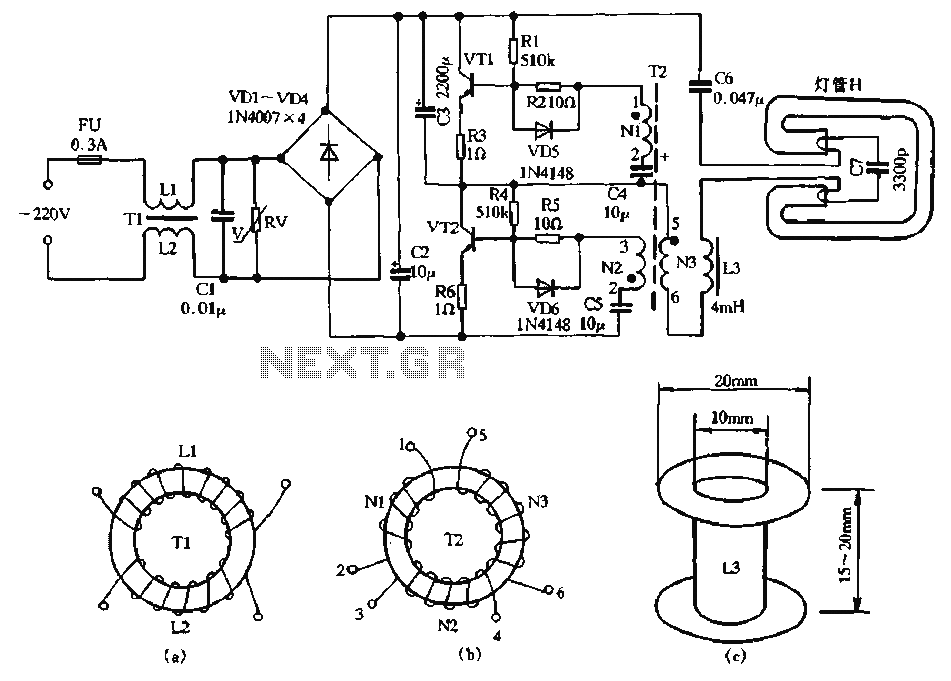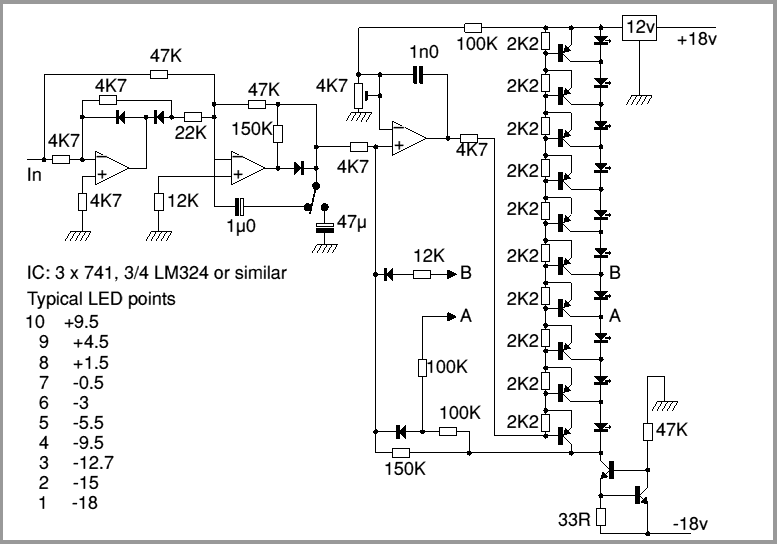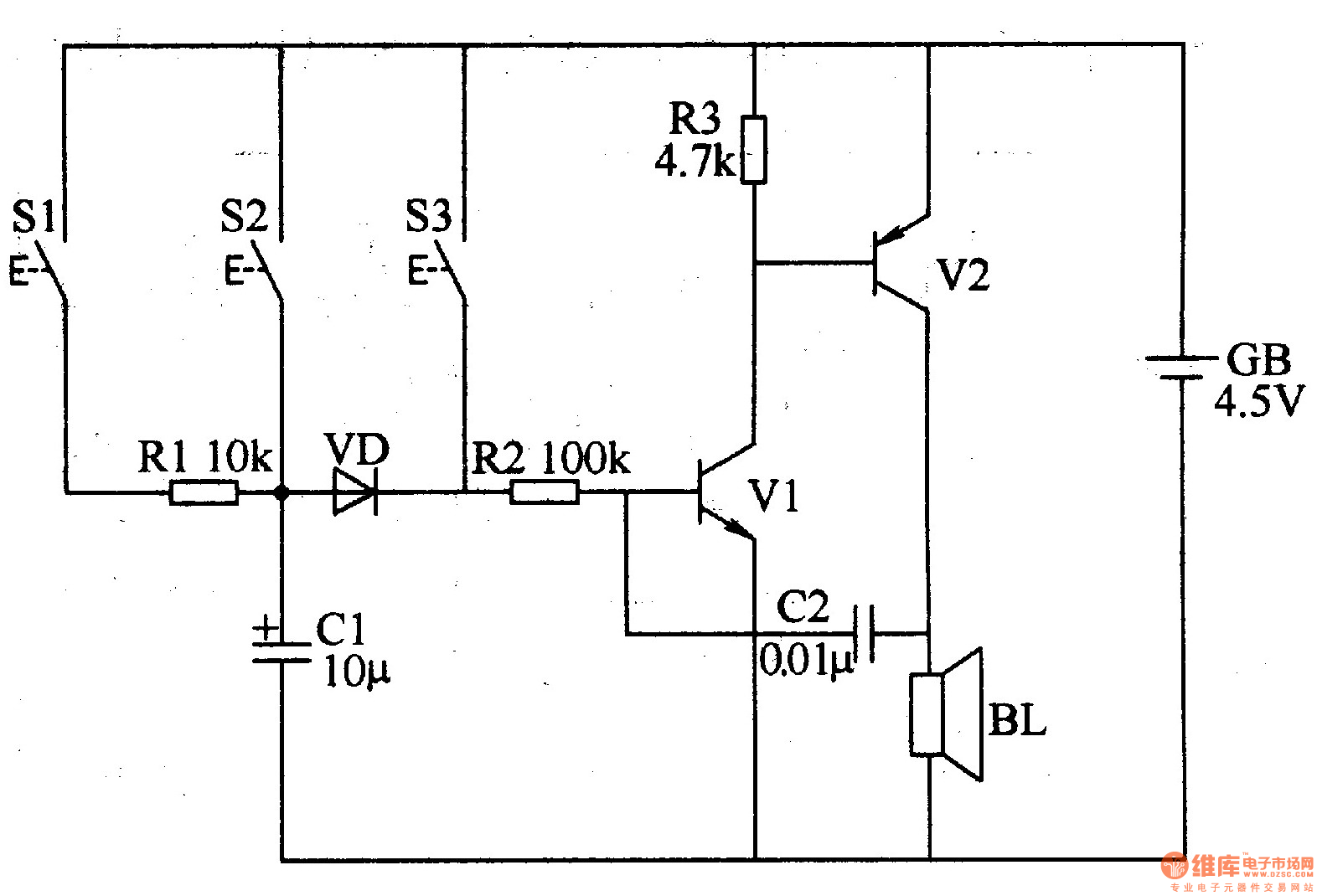
Three-tone electronic doorbell 2

The three-tone electronic doorbell circuit includes a coding trigger circuit, a multi-tone generator, and an audio amplifier circuit, as illustrated in Figure 3-110. The coding trigger circuit is made up of buttons S1-S6, two four-input AND gates (D1, D2) using integrated circuit IC1, along with resistors R1-R11 and transistors Q1-Q3, among other components. The multi-tone sound generator circuit...
The three-tone electronic doorbell circuit is designed to provide distinct audio notifications through a combination of various components. The core of the circuit is the coding trigger circuit, which is activated by pressing any of the six buttons (S1-S6). Each button corresponds to a different tone, allowing the user to select from three distinct sounds. The buttons are connected to two four-input AND gates (D1 and D2), which are part of the integrated circuit IC1. This arrangement ensures that the circuit only triggers when the correct combination of buttons is pressed, effectively coding the input signals.
Resistors R1 to R11 are strategically placed within the circuit to limit current and set appropriate voltage levels for the various components. The transistors Q1 to Q3 serve as switches that control the flow of current to the multi-tone generator, enhancing the circuit's functionality by enabling the amplification of the generated sounds.
The multi-tone generator circuit is responsible for producing the audible tones. It typically consists of oscillators and filters that create the desired sound frequencies. The output from this generator is then fed into an audio amplifier circuit, which boosts the sound level to ensure it can be heard clearly from a distance. The amplifier circuit may include additional components such as capacitors and inductors to enhance sound quality and stability.
Overall, this three-tone electronic doorbell circuit is a sophisticated assembly that combines coding, sound generation, and amplification to deliver a customizable and effective doorbell solution. The careful selection and arrangement of components ensure reliable operation and user satisfaction.The three-tone electronic doorbell circuit consists of the coding triggered circuit, multi-tone generator and audio amplifier circuit, and it is shown in Figure 3-110. Coding trigger circuit is composed of the buttons Sl-S6, two four-input AND gate (DI, D2) integrated circuit ICI, resistors Rl-Rll and transistors Vl-V3 and so on.
Multi-tone sound generator c.. 🔗 External reference
The three-tone electronic doorbell circuit is designed to provide distinct audio notifications through a combination of various components. The core of the circuit is the coding trigger circuit, which is activated by pressing any of the six buttons (S1-S6). Each button corresponds to a different tone, allowing the user to select from three distinct sounds. The buttons are connected to two four-input AND gates (D1 and D2), which are part of the integrated circuit IC1. This arrangement ensures that the circuit only triggers when the correct combination of buttons is pressed, effectively coding the input signals.
Resistors R1 to R11 are strategically placed within the circuit to limit current and set appropriate voltage levels for the various components. The transistors Q1 to Q3 serve as switches that control the flow of current to the multi-tone generator, enhancing the circuit's functionality by enabling the amplification of the generated sounds.
The multi-tone generator circuit is responsible for producing the audible tones. It typically consists of oscillators and filters that create the desired sound frequencies. The output from this generator is then fed into an audio amplifier circuit, which boosts the sound level to ensure it can be heard clearly from a distance. The amplifier circuit may include additional components such as capacitors and inductors to enhance sound quality and stability.
Overall, this three-tone electronic doorbell circuit is a sophisticated assembly that combines coding, sound generation, and amplification to deliver a customizable and effective doorbell solution. The careful selection and arrangement of components ensure reliable operation and user satisfaction.The three-tone electronic doorbell circuit consists of the coding triggered circuit, multi-tone generator and audio amplifier circuit, and it is shown in Figure 3-110. Coding trigger circuit is composed of the buttons Sl-S6, two four-input AND gate (DI, D2) integrated circuit ICI, resistors Rl-Rll and transistors Vl-V3 and so on.
Multi-tone sound generator c.. 🔗 External reference





